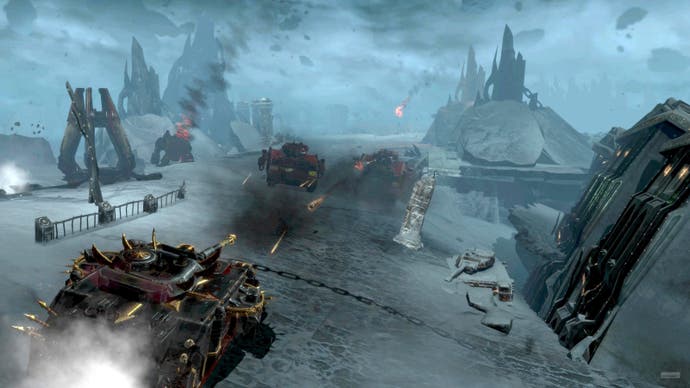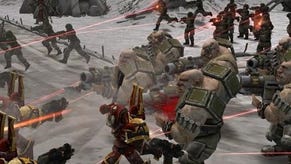Warhammer 40,000: Dawn of War II - Chaos Rising
Mild chaos, turning heavier with a risk of thunder.
Almost universally well-received for its clever integration of RPG elements into the strategy mix, Dawn of War II was a high point for Warhammer's forays into the world of games. As such, when it's time to sit down with the game's associate producer, Jeff Lydell, and talk about an expansion pack, it seems reasonable to ask how the team plans to top its previous performance.
As it turns out, it's not a hard question. The team at Relic, reckons Lydell, are not only very receptive to feedback from players, but also their own harshest critics. "Every time we release a game, we know where the strong points and weak points are," he says (surely begging the question why they release games with weak points, but shh). "When we see how people react to the game, that validates which of those weak points is most important."
With Chaos Rising, the first expansion for DOW2 (it's an "expandalone", Lydell insists on saying repeatedly, despite my pointing out that he's in England now and we like to treat the language with respect), Relic has cast aside the "more of the same" recipe you might expect for an expansion. Instead it's approached the game with a shopping list of things to add and improve.
Take the Chaos race itself. Much beloved of Warhammer aficionados, the Chaos chaps are among the best bad guys in this sprawling fictional universe. Their non-appearance in Dawn of War II was a bitter disappointment to some, but Relic's thinking in reintroducing them in Chaos Rising goes beyond simple fan service. It's a narrative thing, says Lydell - and it's all about one of those weak points the team wanted to fix.

"The Chaos are quite a personal enemy," he explains. "They're not like the Orks, who just want a fight, or the Eldar who are devious and sneaky, or the Tyranids who are just hungry. The Chaos want to kick you in the shins and then laugh in your face."
DOW2's Tyranids, of course, were more of a force of nature than anything else. As a result, Lydell reckons, "they didn't really resonate with people". By comparison, the Chaos provide a meaty narrative for people to get their teeth into: they don't just want to hurt you, they want to force you to mess up (and then hurt you).
From a storytelling point of view, Chaos Rising is hinged on one of the epic science-fiction ideas the Warhammer 40,000 universe rests on. An entire planet, which was previously a bustling metropolis world, emerges from a warp into which it had disappeared some time previously. When it reappears, it's covered in thick sheets of ice - and infected with Chaos. Needless to say, it's not long before the Blood Ravens, stars of the original game, are sent off to investigate.

From the very first mission, Chaos Rising starts setting out its stall and showing off how much Relic has learned and improved since the launch of DOW2. The inclusion of Chaos provides one of the biggest new features, the Corruption meter, a meter on each of your character pages which can, if filled to certain levels, unlock various traits for your squad members.
Filling it up, however, is predicated on how you play the game - whether you act in an honourable, Space Marine style way, or let your anger and impatience get the better of you and barge through with wanton disregard for your surroundings, for example.
This is a much more subtle and important system than DOW2's rather underwhelming Tyranid infestation meta-game. Corruption is a self-selecting difficulty system in its own right, with players forced to actively choose between doing the "pure" thing (which may be a lot harder) and doing the "corrupt" thing (which is probably much easier).





